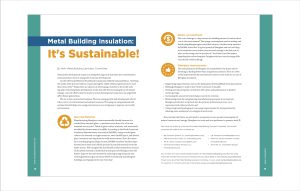Metal Building Insulation: It’s Sustainable!
Sustainable development requires an integrated approach that takes into consideration environmental concerns along with economic development.
In 1987, the United Nations Brundtland Commission defined sustainability as, “meeting the needs of the present without compromising the ability of future generations to meet their own needs.” Today, there are almost 140 developing countries in the world seeking ways of meeting their development needs; but with the increasing threat of climate change, concrete efforts must be made to ensure development today does not negatively affect future generations.
We are in the construction business. We love seeing growth and development. But at what cost to our environment and natural resources? Focusing on using materials and systems that will help save energy and resources is a strong way to improve our world’s environment.
Recycled Materials
Manufacturing fiberglass is environmentally friendly because it is created from recycled glass—sometimes more than 50% of its raw materials are recycled. Think of glass bottles, windows, and automobile windshields thrown away in landfills. According to the North American Insulation Manufacturers Association (NAIMA), using recycled glass reduces the demand on virgin resources, saves landfill space, and diverts glass containers and slag from the solid waste stream. Since the industry’s recycling program began in 1992, NAIMA members’ facilities have diverted more than 103.5 billion pounds of recycled materials from the waste stream. Now imagine the dual benefit as that tremendous amount of discarded material is melted down and spun into fiberglass that will further improve the environment by reducing energy demands and carbon/greenhouse gas emissions while economically insulating the buildings and equipment we use every day!
Return on Investment
The cost of energy is a big concern for building owners, but what about cost to the environment? The energy consumption used in making and distributing fiberglass gives excellent returns. Another study reported by NAIMA states that “a typical pound of fiberglass and rock and slag wool insulation saves twelve times as much energy in its first year in place as the energy used to produce it.” And that is just the impact regarding the carbon footprint. Imagine what you save in energy bills over the life of the building!
Fiberglass Improvements
The manufacturers of fiberglass are committed to the future and to investing in finding better ways and greener products. Here are a few of the improvements by manufacturers that we now enjoy in our use of fiberglass insulation.
- Engineering improvements, such as the elimination of formaldehyde from its products;
- Refining fiberglass to make it less “itchy” and easier to handle;
- Testing and improving the consistency of R-values and performance in limited cavity spacings;
- Increasing the amount of recycled glass used in its creation;
- Eliminating waste by reengineering manufacturing processes to incorporate fiberglass production scrap back into the primary production process, or to reprocess it into other products; and
- Using compressed packaging to cut energy requirements for transportation by allowing more insulation to be shipped in each truck.
Now and into the future, we will need to economize on our use and consumption of natural resources and energy. Fiberglass is a tried-and-true performer to preserve both.

